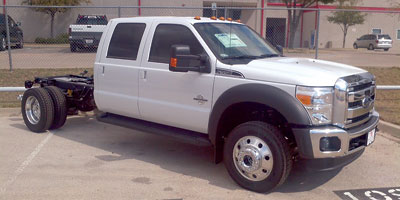2015 Medium-Duty Sales Surpass 200,000 as Growth Is Consistent Among All Classes
Sales of medium-duty trucks for all of 2015 were the highest since 2007, with all weight classes showing growth, WardsAuto.com said.
Truck makers and their dealers sold 200,654 Classes 4-7 trucks, up 7.7% from 186,342 in 2014.
In 2007, U.S. retail sales were 220,128 medium trucks. Sales reached their highest total in more than 25 years when they soared to 260,573 units in 2006.
 TDY Sales
TDY SalesClass 7 trucks led the way in sales gains by percentage in 2015, rising 8.7% to 58,888 vehicles, and Class 6 climbed 6.6% to 55,118 units, while Classes 4 and 5, combined, rose 7.7% to 86,648.
Classes 4 and 5 accounted for 43.2% of 2015’s total, Class 6 was 27.5% and Class 7 made up 29.3%.
For the year’s final month, medium sales rose by 10.7% to 20,735 trucks from 18,731, year over year.
On the heavier end, Class 7 sales declined 2.1% to 5,188 trucks, and Class 6 grew by 7.9% to 5,109 units.
Lighter Classes 4-5 vehicles jumped 20% to 10,438 trucks.
Analysts saw modest gains in the future from government sales and an economy powered by consumers.
Don Ake, an analyst with the research firm FTR Associates, told Transport Topics that, in 2016, he expects “Class 6-7 growth to be maybe 1% and Class 4-5 to be about 6.5%.”
Ake said state and municipal governments would continue to replace vehicles. “They are still playing catch-up.”
Michael Baudendistel, an analyst with Stifel, Nicolaus & Co., said in a note to investors this month, “We believe North American medium-duty markets will hold up better in 2016 than heavy-duty [markets] but won’t show robust growth.”
“We are assuming production is roughly flat in 2016 and grows more or less in line with the economy in the few years that follow,” Baudendistel said.
Jamie Cook, an analyst with Credit Suisse, said in a recent note to investors, “As opposed to heavy-duty, which serves more of the industrial economy, the medium-duty [market] makes sense, reflecting relative strength in the consumer economy.”
In Class 7 sales for the year, Freightliner Trucks maintained its dominance in the segment, selling 26,251 trucks, a 5.1% increase over 24,979 in 2014.
Freightliner is a brand of Daimler Trucks North America.
International Trucks by Navistar Inc. held onto second place in the grouping, selling 16,677 trucks, a 14.9% gain over the previous year’s 14,513.
The two operating companies of Paccar Inc. took third place in Class 7. Peterbilt Motors and Kenworth Trucks, combined, gained 19.3% to 10,987 Class 7s.
In Class 6, Freightliner also led for the year but was followed by Ford Motor Co., International, Hino Trucks and Paccar, in slots two to five.
Freightliner sold 19,842 Class 6s for the year, a gain of 7.2% over 2014. Ford moved 14,805 trucks, down 7.7% from 2014. International gained 15.7% to 10,951 vehicles.
Ford controlled a majority of Class 4-5 U.S. retail sales, moving 47,047 trucks, or 54.3% of the segment. A year ago the OEM sold 42,871 units, or 53.3% of the 4-5 segment.
Mike Levine, Ford’s truck communications manager, told TT sales of its F-550 vehicle, which is a chassis-and-cab configuration, appealed to a range of vocational customers.
“So you are talking about people with a specific job to do, and they go to the aftermarket for a specific body, whether that is a dump body, stake, tow or utility body,” he said.
Levine added that sales of the truck, which is available with either a gasoline or diesel engine, were being driven by the strength of the home construction industry.
“And they can get a power takeoff off the diesel engine. Maybe they have to power a dump body off the truck, they can use [the PTO] for that,” Levine said.
The two other major brands in Class 4-5 were Isuzu Trucks with 15,942 trucks sold for the year, and the Ram division of Fiat Chrysler with 15,812 units. Both of those companies also posted year over year sales gains.
Looking at economic activity that drives medium-duty volumes, the Congressional Budget Office said earlier this month that it forecasts gross domestic product adjusted for inflation will grow by 3.1% in 2016 and by 2.7% in 2017.
For 2018 and 2019, the agency projects that the economy will grow at an average annual rate of 2.2%. The CBO report said increases in consumer spending, business investment and residential investment will be the main economic drivers of growth.

